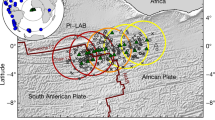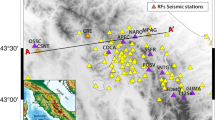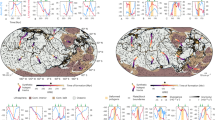Abstract
PROF. J. TUZO WILSON1–3 has suggested that mountains, mid-ocean ridges, and major horizontal shear faults are not isolated features, that few come to dead ends, but that they are connected into a continuous network of mobile belts around the Earth which divide the surface into several large rigid plates.
This is a preview of subscription content, access via your institution
Access options
Subscribe to this journal
Receive 51 print issues and online access
$199.00 per year
only $3.90 per issue
Buy this article
- Purchase on SpringerLink
- Instant access to full article PDF
Prices may be subject to local taxes which are calculated during checkout
Similar content being viewed by others
References
Wilson, J. T., Nature, 207, 343 (1965).
Wilson, J. T., Science, 150, 482 (1965).
Wilson, J. T., Nature, 207, 907 (1965).
Hernes, I., Nature, 200, 1308 (1963).
Hernes, I., Nature, 204, 1186 (1964).
Jacobs, J. A., Russell, R. D., and Wilson, J. T., Physics and Geology (McGraw-Hill, New York, 1959).
Hernes, I., Neues Jb. Geol. Paläont. Mh. (in the press).
Cloos, H., Fortschr. Geol. Palaeont., 7, 233 (1928).
de Sitter, L. U., Structural Geology, second ed. (McGraw-Hill, New York, 1964).
Stille, H., Abh. Preuss. Geol. Landesanstalt, 95, 110 (1925).
Author information
Authors and Affiliations
Rights and permissions
About this article
Cite this article
HERNES, I. Global Network of Mobile Belts. Nature 210, 725–726 (1966). https://doi.org/10.1038/210725b0
Issue date:
DOI: https://doi.org/10.1038/210725b0



